Retail Industry: Supply Chain Strategies, Configuration and Technology
VerifiedAdded on 2023/04/06
|17
|3823
|68
Report
AI Summary
This report examines supply chain strategies within the retail industry, focusing on design, implementation, and collaboration. It explores lean principles, agile methodologies, and Leagile strategies, highlighting how these configurations maximize performance and contribute to competitive advantage. The analysis includes the utilization of advanced technologies like big data analytics, IoT, and cloud computing by retail companies. Examples such as Walmart and ALDI are used to illustrate the practical application of these strategies and technologies in enhancing efficiency and maintaining a competitive edge in the retail sector. The report concludes by emphasizing the importance of adapting to technological changes and configuring supply chains effectively.
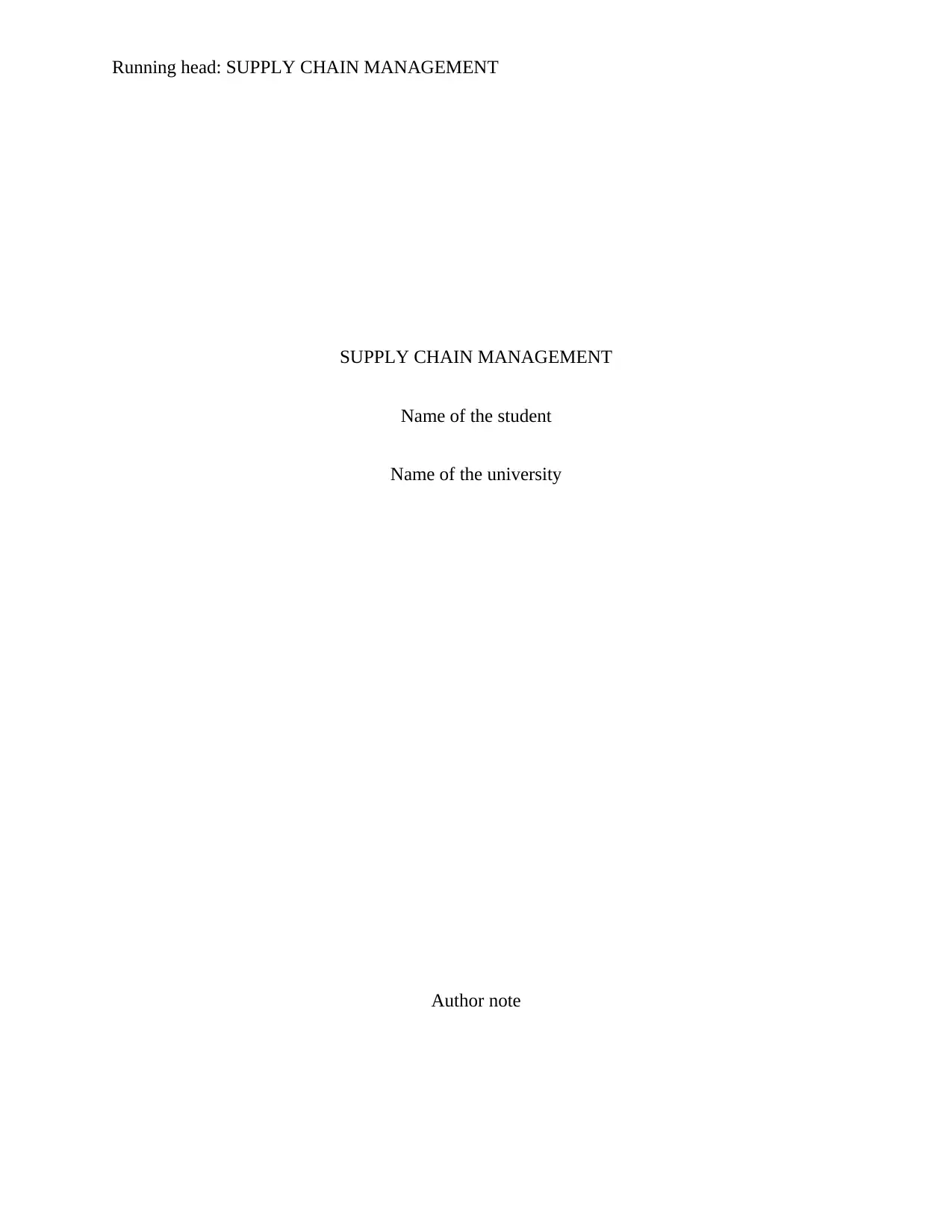
Running head: SUPPLY CHAIN MANAGEMENT
SUPPLY CHAIN MANAGEMENT
Name of the student
Name of the university
Author note
SUPPLY CHAIN MANAGEMENT
Name of the student
Name of the university
Author note
Paraphrase This Document
Need a fresh take? Get an instant paraphrase of this document with our AI Paraphraser
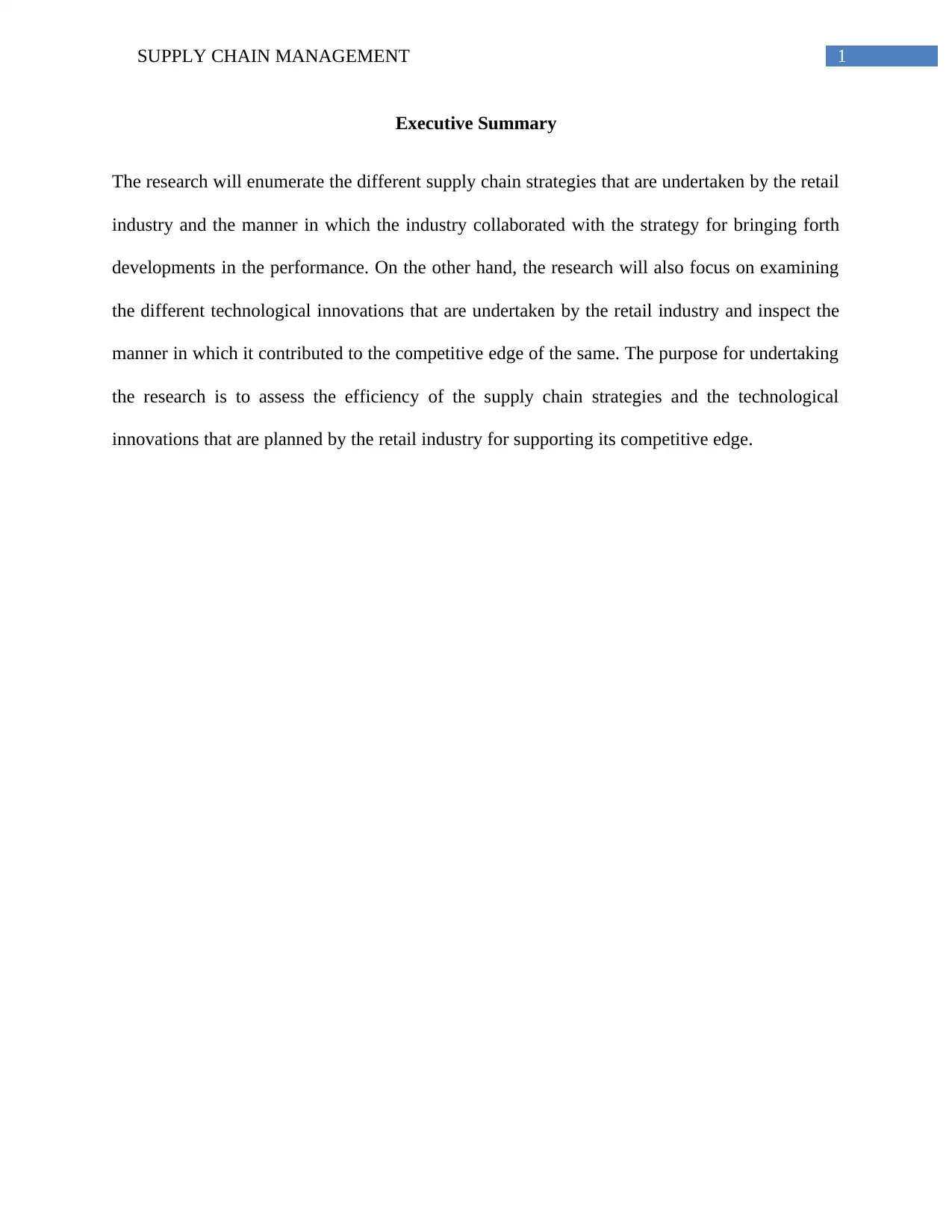
1SUPPLY CHAIN MANAGEMENT
Executive Summary
The research will enumerate the different supply chain strategies that are undertaken by the retail
industry and the manner in which the industry collaborated with the strategy for bringing forth
developments in the performance. On the other hand, the research will also focus on examining
the different technological innovations that are undertaken by the retail industry and inspect the
manner in which it contributed to the competitive edge of the same. The purpose for undertaking
the research is to assess the efficiency of the supply chain strategies and the technological
innovations that are planned by the retail industry for supporting its competitive edge.
Executive Summary
The research will enumerate the different supply chain strategies that are undertaken by the retail
industry and the manner in which the industry collaborated with the strategy for bringing forth
developments in the performance. On the other hand, the research will also focus on examining
the different technological innovations that are undertaken by the retail industry and inspect the
manner in which it contributed to the competitive edge of the same. The purpose for undertaking
the research is to assess the efficiency of the supply chain strategies and the technological
innovations that are planned by the retail industry for supporting its competitive edge.
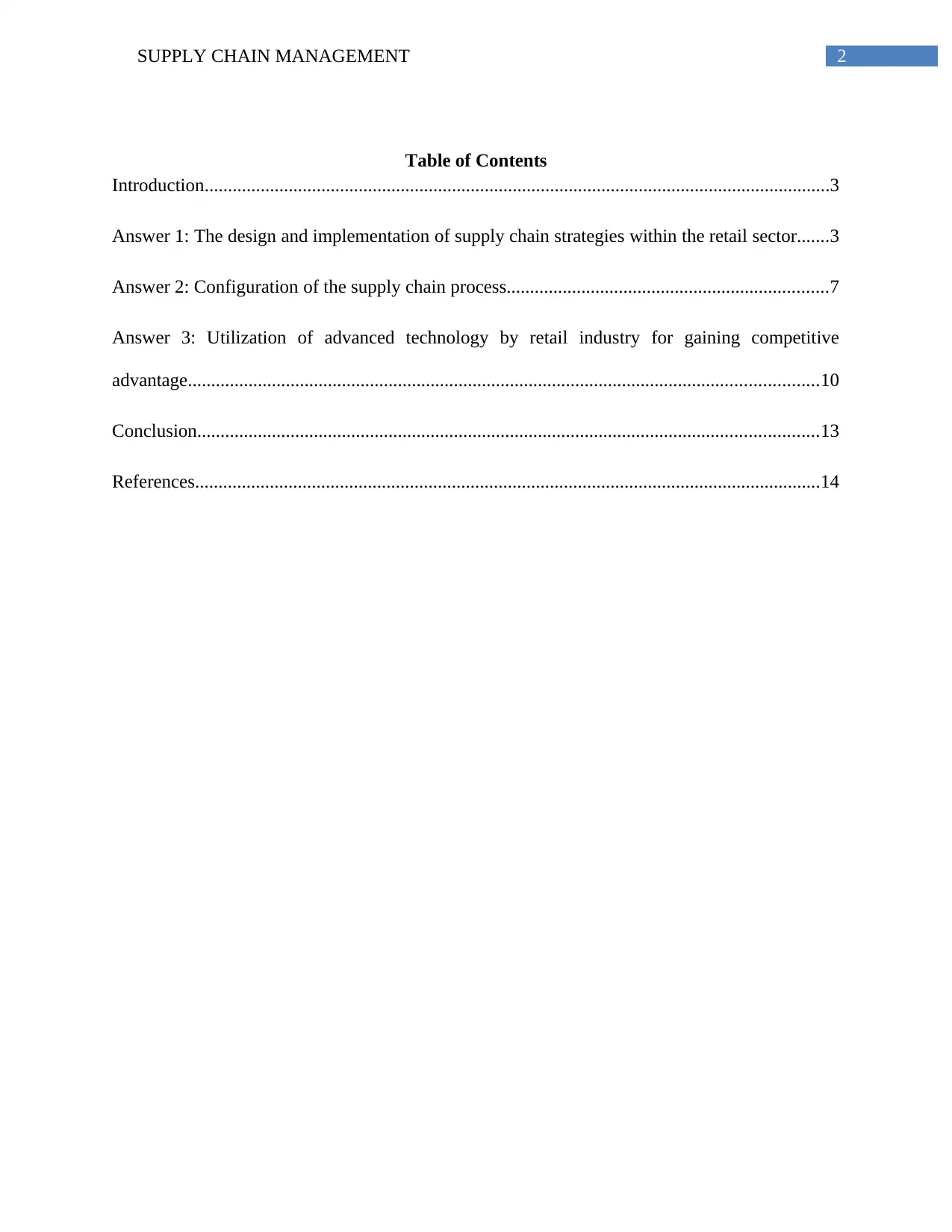
2SUPPLY CHAIN MANAGEMENT
Table of Contents
Introduction......................................................................................................................................3
Answer 1: The design and implementation of supply chain strategies within the retail sector.......3
Answer 2: Configuration of the supply chain process.....................................................................7
Answer 3: Utilization of advanced technology by retail industry for gaining competitive
advantage.......................................................................................................................................10
Conclusion.....................................................................................................................................13
References......................................................................................................................................14
Table of Contents
Introduction......................................................................................................................................3
Answer 1: The design and implementation of supply chain strategies within the retail sector.......3
Answer 2: Configuration of the supply chain process.....................................................................7
Answer 3: Utilization of advanced technology by retail industry for gaining competitive
advantage.......................................................................................................................................10
Conclusion.....................................................................................................................................13
References......................................................................................................................................14
⊘ This is a preview!⊘
Do you want full access?
Subscribe today to unlock all pages.

Trusted by 1+ million students worldwide
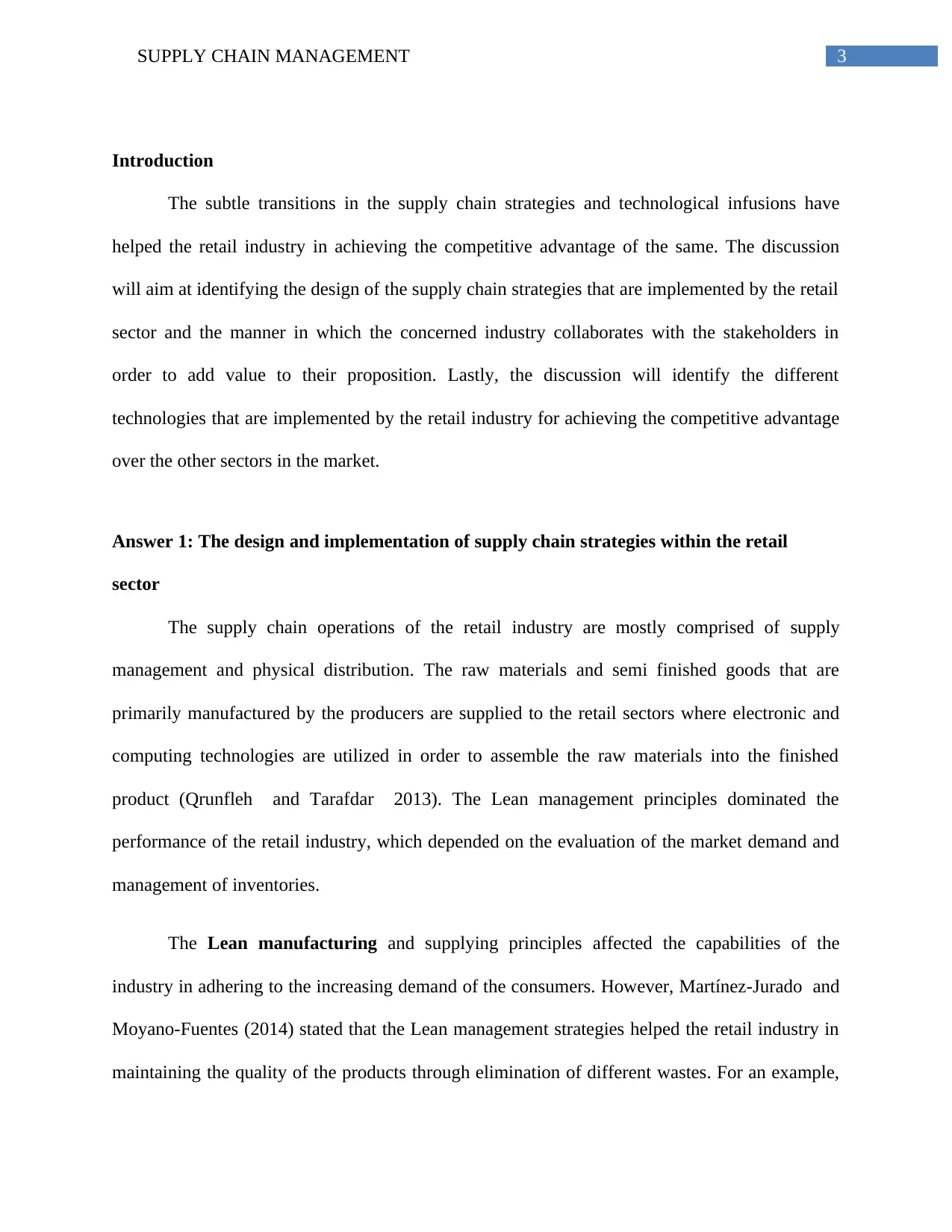
3SUPPLY CHAIN MANAGEMENT
Introduction
The subtle transitions in the supply chain strategies and technological infusions have
helped the retail industry in achieving the competitive advantage of the same. The discussion
will aim at identifying the design of the supply chain strategies that are implemented by the retail
sector and the manner in which the concerned industry collaborates with the stakeholders in
order to add value to their proposition. Lastly, the discussion will identify the different
technologies that are implemented by the retail industry for achieving the competitive advantage
over the other sectors in the market.
Answer 1: The design and implementation of supply chain strategies within the retail
sector
The supply chain operations of the retail industry are mostly comprised of supply
management and physical distribution. The raw materials and semi finished goods that are
primarily manufactured by the producers are supplied to the retail sectors where electronic and
computing technologies are utilized in order to assemble the raw materials into the finished
product (Qrunfleh and Tarafdar 2013). The Lean management principles dominated the
performance of the retail industry, which depended on the evaluation of the market demand and
management of inventories.
The Lean manufacturing and supplying principles affected the capabilities of the
industry in adhering to the increasing demand of the consumers. However, Martínez-Jurado and
Moyano-Fuentes (2014) stated that the Lean management strategies helped the retail industry in
maintaining the quality of the products through elimination of different wastes. For an example,
Introduction
The subtle transitions in the supply chain strategies and technological infusions have
helped the retail industry in achieving the competitive advantage of the same. The discussion
will aim at identifying the design of the supply chain strategies that are implemented by the retail
sector and the manner in which the concerned industry collaborates with the stakeholders in
order to add value to their proposition. Lastly, the discussion will identify the different
technologies that are implemented by the retail industry for achieving the competitive advantage
over the other sectors in the market.
Answer 1: The design and implementation of supply chain strategies within the retail
sector
The supply chain operations of the retail industry are mostly comprised of supply
management and physical distribution. The raw materials and semi finished goods that are
primarily manufactured by the producers are supplied to the retail sectors where electronic and
computing technologies are utilized in order to assemble the raw materials into the finished
product (Qrunfleh and Tarafdar 2013). The Lean management principles dominated the
performance of the retail industry, which depended on the evaluation of the market demand and
management of inventories.
The Lean manufacturing and supplying principles affected the capabilities of the
industry in adhering to the increasing demand of the consumers. However, Martínez-Jurado and
Moyano-Fuentes (2014) stated that the Lean management strategies helped the retail industry in
maintaining the quality of the products through elimination of different wastes. For an example,
Paraphrase This Document
Need a fresh take? Get an instant paraphrase of this document with our AI Paraphraser
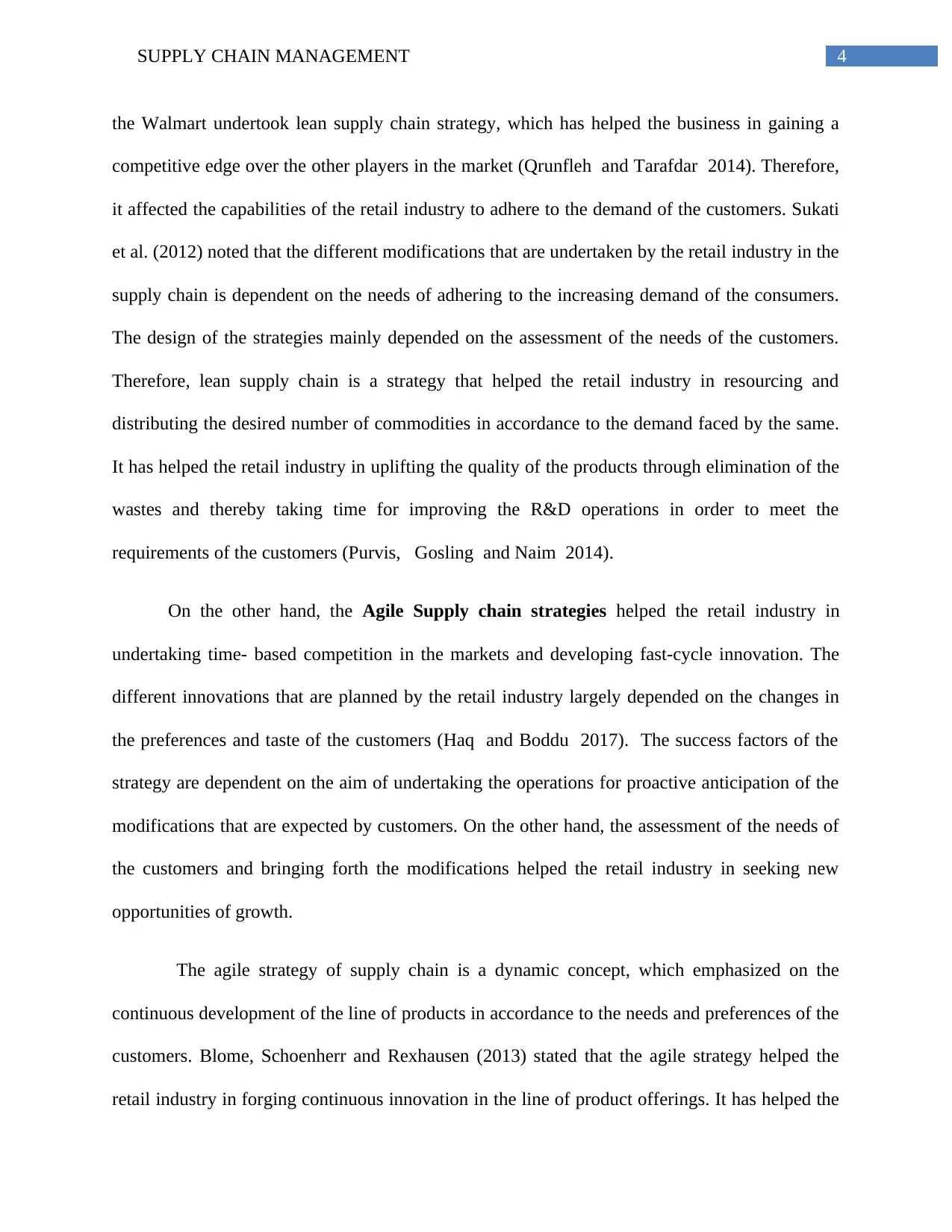
4SUPPLY CHAIN MANAGEMENT
the Walmart undertook lean supply chain strategy, which has helped the business in gaining a
competitive edge over the other players in the market (Qrunfleh and Tarafdar 2014). Therefore,
it affected the capabilities of the retail industry to adhere to the demand of the customers. Sukati
et al. (2012) noted that the different modifications that are undertaken by the retail industry in the
supply chain is dependent on the needs of adhering to the increasing demand of the consumers.
The design of the strategies mainly depended on the assessment of the needs of the customers.
Therefore, lean supply chain is a strategy that helped the retail industry in resourcing and
distributing the desired number of commodities in accordance to the demand faced by the same.
It has helped the retail industry in uplifting the quality of the products through elimination of the
wastes and thereby taking time for improving the R&D operations in order to meet the
requirements of the customers (Purvis, Gosling and Naim 2014).
On the other hand, the Agile Supply chain strategies helped the retail industry in
undertaking time- based competition in the markets and developing fast-cycle innovation. The
different innovations that are planned by the retail industry largely depended on the changes in
the preferences and taste of the customers (Haq and Boddu 2017). The success factors of the
strategy are dependent on the aim of undertaking the operations for proactive anticipation of the
modifications that are expected by customers. On the other hand, the assessment of the needs of
the customers and bringing forth the modifications helped the retail industry in seeking new
opportunities of growth.
The agile strategy of supply chain is a dynamic concept, which emphasized on the
continuous development of the line of products in accordance to the needs and preferences of the
customers. Blome, Schoenherr and Rexhausen (2013) stated that the agile strategy helped the
retail industry in forging continuous innovation in the line of product offerings. It has helped the
the Walmart undertook lean supply chain strategy, which has helped the business in gaining a
competitive edge over the other players in the market (Qrunfleh and Tarafdar 2014). Therefore,
it affected the capabilities of the retail industry to adhere to the demand of the customers. Sukati
et al. (2012) noted that the different modifications that are undertaken by the retail industry in the
supply chain is dependent on the needs of adhering to the increasing demand of the consumers.
The design of the strategies mainly depended on the assessment of the needs of the customers.
Therefore, lean supply chain is a strategy that helped the retail industry in resourcing and
distributing the desired number of commodities in accordance to the demand faced by the same.
It has helped the retail industry in uplifting the quality of the products through elimination of the
wastes and thereby taking time for improving the R&D operations in order to meet the
requirements of the customers (Purvis, Gosling and Naim 2014).
On the other hand, the Agile Supply chain strategies helped the retail industry in
undertaking time- based competition in the markets and developing fast-cycle innovation. The
different innovations that are planned by the retail industry largely depended on the changes in
the preferences and taste of the customers (Haq and Boddu 2017). The success factors of the
strategy are dependent on the aim of undertaking the operations for proactive anticipation of the
modifications that are expected by customers. On the other hand, the assessment of the needs of
the customers and bringing forth the modifications helped the retail industry in seeking new
opportunities of growth.
The agile strategy of supply chain is a dynamic concept, which emphasized on the
continuous development of the line of products in accordance to the needs and preferences of the
customers. Blome, Schoenherr and Rexhausen (2013) stated that the agile strategy helped the
retail industry in forging continuous innovation in the line of product offerings. It has helped the
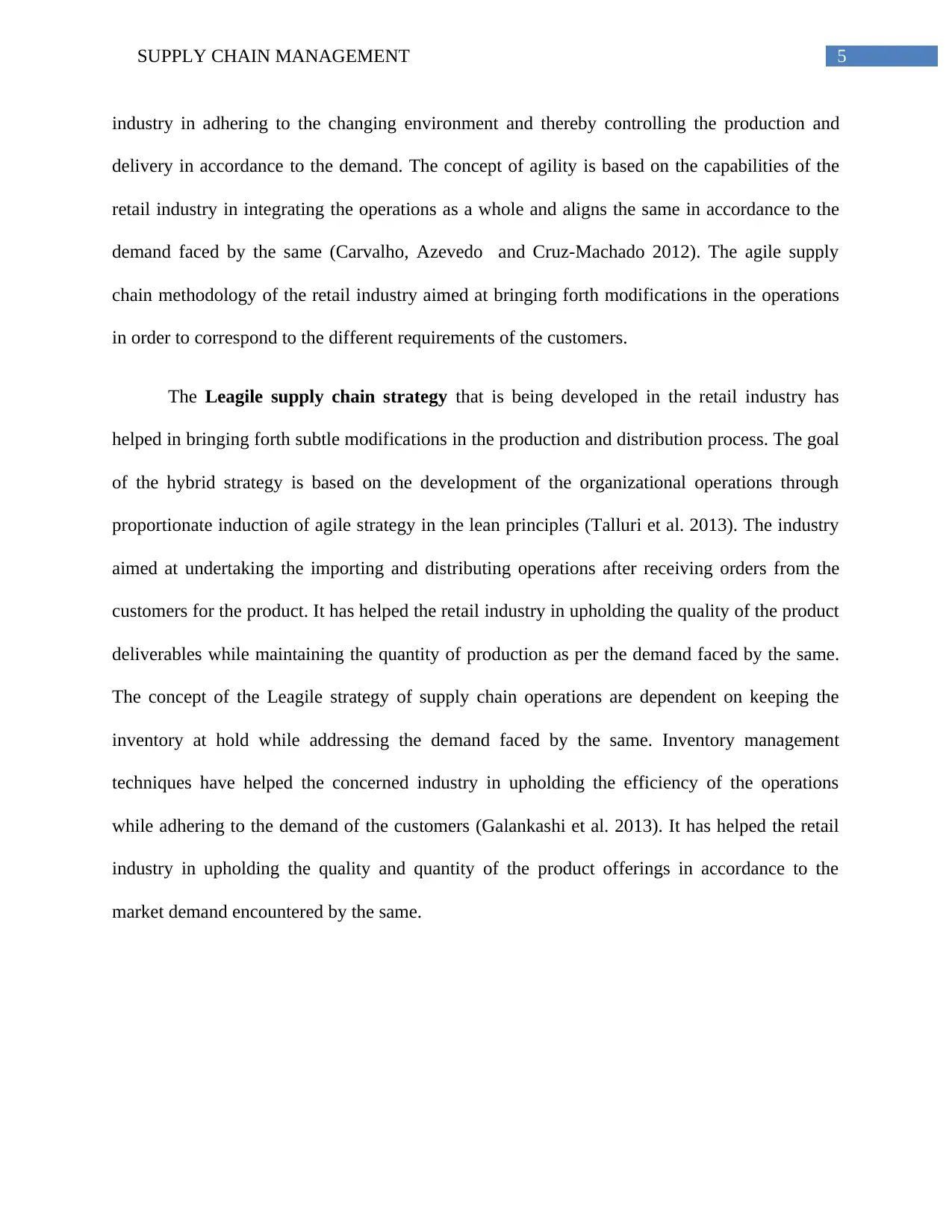
5SUPPLY CHAIN MANAGEMENT
industry in adhering to the changing environment and thereby controlling the production and
delivery in accordance to the demand. The concept of agility is based on the capabilities of the
retail industry in integrating the operations as a whole and aligns the same in accordance to the
demand faced by the same (Carvalho, Azevedo and Cruz-Machado 2012). The agile supply
chain methodology of the retail industry aimed at bringing forth modifications in the operations
in order to correspond to the different requirements of the customers.
The Leagile supply chain strategy that is being developed in the retail industry has
helped in bringing forth subtle modifications in the production and distribution process. The goal
of the hybrid strategy is based on the development of the organizational operations through
proportionate induction of agile strategy in the lean principles (Talluri et al. 2013). The industry
aimed at undertaking the importing and distributing operations after receiving orders from the
customers for the product. It has helped the retail industry in upholding the quality of the product
deliverables while maintaining the quantity of production as per the demand faced by the same.
The concept of the Leagile strategy of supply chain operations are dependent on keeping the
inventory at hold while addressing the demand faced by the same. Inventory management
techniques have helped the concerned industry in upholding the efficiency of the operations
while adhering to the demand of the customers (Galankashi et al. 2013). It has helped the retail
industry in upholding the quality and quantity of the product offerings in accordance to the
market demand encountered by the same.
industry in adhering to the changing environment and thereby controlling the production and
delivery in accordance to the demand. The concept of agility is based on the capabilities of the
retail industry in integrating the operations as a whole and aligns the same in accordance to the
demand faced by the same (Carvalho, Azevedo and Cruz-Machado 2012). The agile supply
chain methodology of the retail industry aimed at bringing forth modifications in the operations
in order to correspond to the different requirements of the customers.
The Leagile supply chain strategy that is being developed in the retail industry has
helped in bringing forth subtle modifications in the production and distribution process. The goal
of the hybrid strategy is based on the development of the organizational operations through
proportionate induction of agile strategy in the lean principles (Talluri et al. 2013). The industry
aimed at undertaking the importing and distributing operations after receiving orders from the
customers for the product. It has helped the retail industry in upholding the quality of the product
deliverables while maintaining the quantity of production as per the demand faced by the same.
The concept of the Leagile strategy of supply chain operations are dependent on keeping the
inventory at hold while addressing the demand faced by the same. Inventory management
techniques have helped the concerned industry in upholding the efficiency of the operations
while adhering to the demand of the customers (Galankashi et al. 2013). It has helped the retail
industry in upholding the quality and quantity of the product offerings in accordance to the
market demand encountered by the same.
⊘ This is a preview!⊘
Do you want full access?
Subscribe today to unlock all pages.

Trusted by 1+ million students worldwide
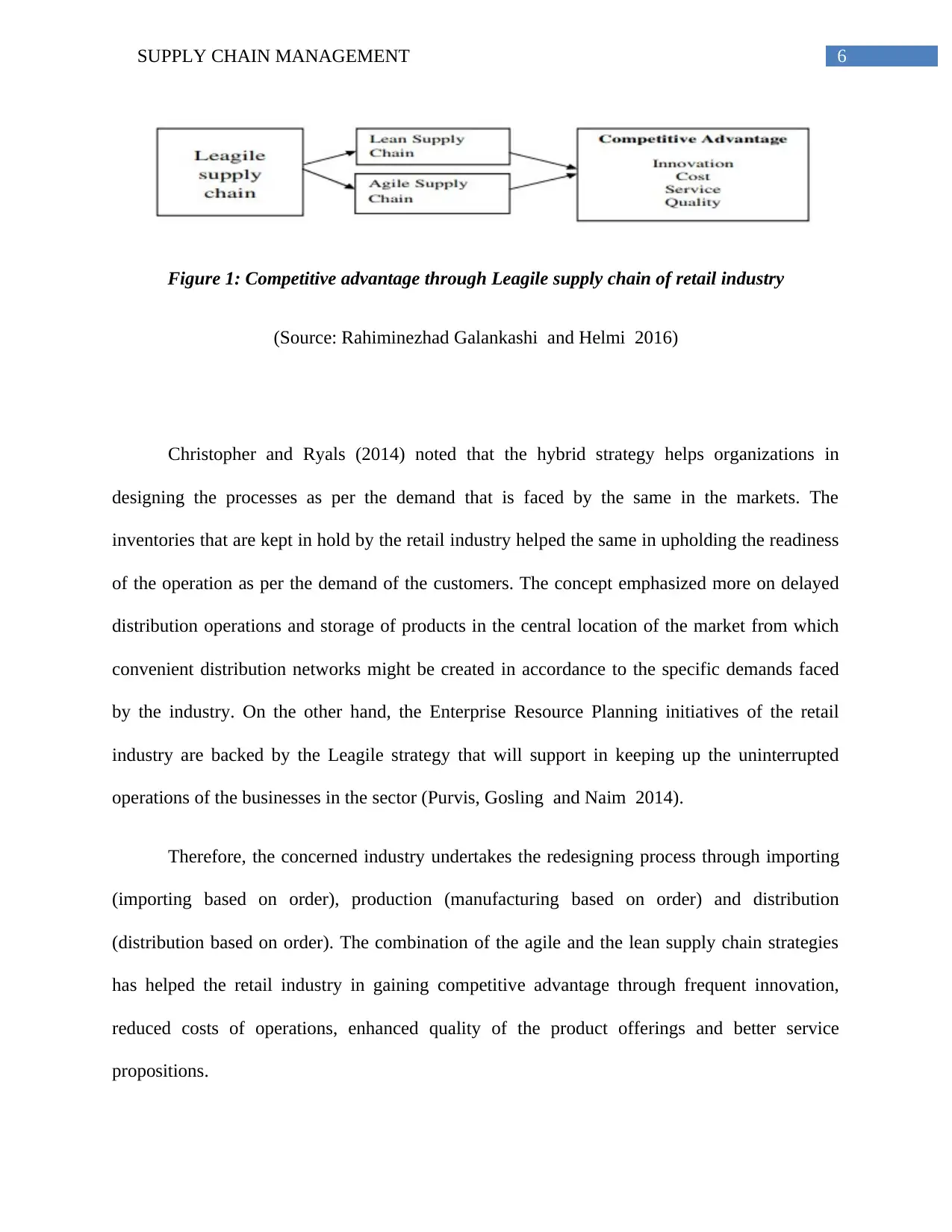
6SUPPLY CHAIN MANAGEMENT
Figure 1: Competitive advantage through Leagile supply chain of retail industry
(Source: Rahiminezhad Galankashi and Helmi 2016)
Christopher and Ryals (2014) noted that the hybrid strategy helps organizations in
designing the processes as per the demand that is faced by the same in the markets. The
inventories that are kept in hold by the retail industry helped the same in upholding the readiness
of the operation as per the demand of the customers. The concept emphasized more on delayed
distribution operations and storage of products in the central location of the market from which
convenient distribution networks might be created in accordance to the specific demands faced
by the industry. On the other hand, the Enterprise Resource Planning initiatives of the retail
industry are backed by the Leagile strategy that will support in keeping up the uninterrupted
operations of the businesses in the sector (Purvis, Gosling and Naim 2014).
Therefore, the concerned industry undertakes the redesigning process through importing
(importing based on order), production (manufacturing based on order) and distribution
(distribution based on order). The combination of the agile and the lean supply chain strategies
has helped the retail industry in gaining competitive advantage through frequent innovation,
reduced costs of operations, enhanced quality of the product offerings and better service
propositions.
Figure 1: Competitive advantage through Leagile supply chain of retail industry
(Source: Rahiminezhad Galankashi and Helmi 2016)
Christopher and Ryals (2014) noted that the hybrid strategy helps organizations in
designing the processes as per the demand that is faced by the same in the markets. The
inventories that are kept in hold by the retail industry helped the same in upholding the readiness
of the operation as per the demand of the customers. The concept emphasized more on delayed
distribution operations and storage of products in the central location of the market from which
convenient distribution networks might be created in accordance to the specific demands faced
by the industry. On the other hand, the Enterprise Resource Planning initiatives of the retail
industry are backed by the Leagile strategy that will support in keeping up the uninterrupted
operations of the businesses in the sector (Purvis, Gosling and Naim 2014).
Therefore, the concerned industry undertakes the redesigning process through importing
(importing based on order), production (manufacturing based on order) and distribution
(distribution based on order). The combination of the agile and the lean supply chain strategies
has helped the retail industry in gaining competitive advantage through frequent innovation,
reduced costs of operations, enhanced quality of the product offerings and better service
propositions.
Paraphrase This Document
Need a fresh take? Get an instant paraphrase of this document with our AI Paraphraser
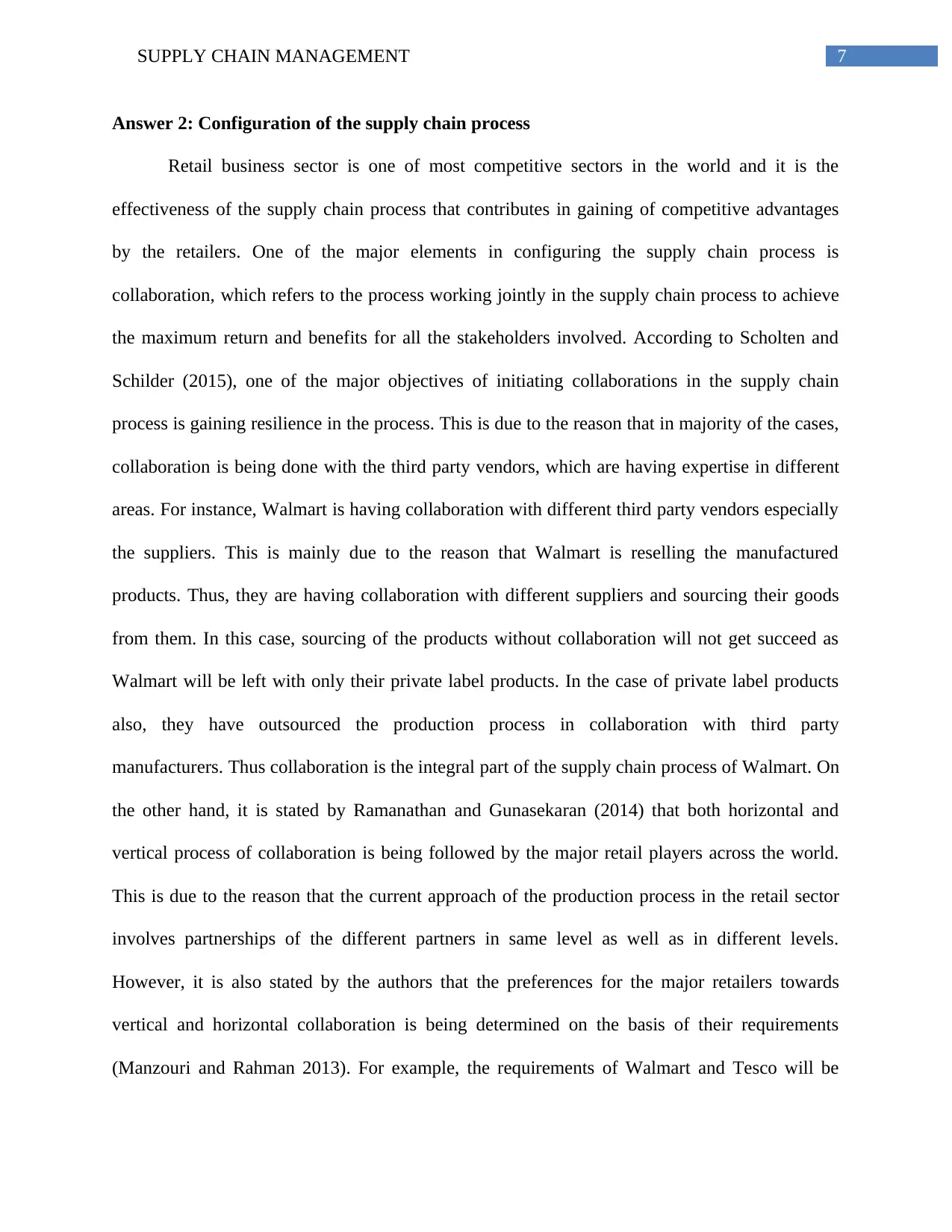
7SUPPLY CHAIN MANAGEMENT
Answer 2: Configuration of the supply chain process
Retail business sector is one of most competitive sectors in the world and it is the
effectiveness of the supply chain process that contributes in gaining of competitive advantages
by the retailers. One of the major elements in configuring the supply chain process is
collaboration, which refers to the process working jointly in the supply chain process to achieve
the maximum return and benefits for all the stakeholders involved. According to Scholten and
Schilder (2015), one of the major objectives of initiating collaborations in the supply chain
process is gaining resilience in the process. This is due to the reason that in majority of the cases,
collaboration is being done with the third party vendors, which are having expertise in different
areas. For instance, Walmart is having collaboration with different third party vendors especially
the suppliers. This is mainly due to the reason that Walmart is reselling the manufactured
products. Thus, they are having collaboration with different suppliers and sourcing their goods
from them. In this case, sourcing of the products without collaboration will not get succeed as
Walmart will be left with only their private label products. In the case of private label products
also, they have outsourced the production process in collaboration with third party
manufacturers. Thus collaboration is the integral part of the supply chain process of Walmart. On
the other hand, it is stated by Ramanathan and Gunasekaran (2014) that both horizontal and
vertical process of collaboration is being followed by the major retail players across the world.
This is due to the reason that the current approach of the production process in the retail sector
involves partnerships of the different partners in same level as well as in different levels.
However, it is also stated by the authors that the preferences for the major retailers towards
vertical and horizontal collaboration is being determined on the basis of their requirements
(Manzouri and Rahman 2013). For example, the requirements of Walmart and Tesco will be
Answer 2: Configuration of the supply chain process
Retail business sector is one of most competitive sectors in the world and it is the
effectiveness of the supply chain process that contributes in gaining of competitive advantages
by the retailers. One of the major elements in configuring the supply chain process is
collaboration, which refers to the process working jointly in the supply chain process to achieve
the maximum return and benefits for all the stakeholders involved. According to Scholten and
Schilder (2015), one of the major objectives of initiating collaborations in the supply chain
process is gaining resilience in the process. This is due to the reason that in majority of the cases,
collaboration is being done with the third party vendors, which are having expertise in different
areas. For instance, Walmart is having collaboration with different third party vendors especially
the suppliers. This is mainly due to the reason that Walmart is reselling the manufactured
products. Thus, they are having collaboration with different suppliers and sourcing their goods
from them. In this case, sourcing of the products without collaboration will not get succeed as
Walmart will be left with only their private label products. In the case of private label products
also, they have outsourced the production process in collaboration with third party
manufacturers. Thus collaboration is the integral part of the supply chain process of Walmart. On
the other hand, it is stated by Ramanathan and Gunasekaran (2014) that both horizontal and
vertical process of collaboration is being followed by the major retail players across the world.
This is due to the reason that the current approach of the production process in the retail sector
involves partnerships of the different partners in same level as well as in different levels.
However, it is also stated by the authors that the preferences for the major retailers towards
vertical and horizontal collaboration is being determined on the basis of their requirements
(Manzouri and Rahman 2013). For example, the requirements of Walmart and Tesco will be
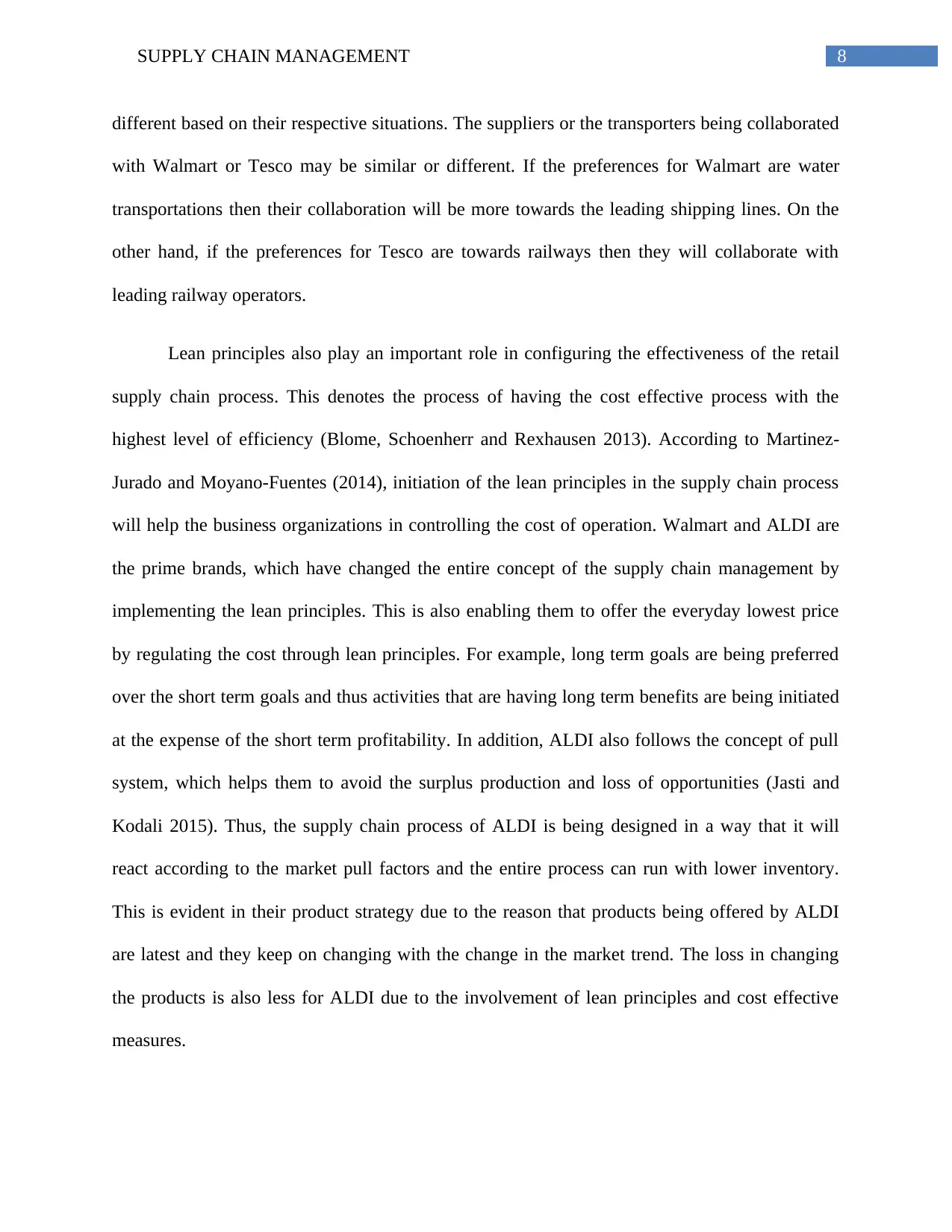
8SUPPLY CHAIN MANAGEMENT
different based on their respective situations. The suppliers or the transporters being collaborated
with Walmart or Tesco may be similar or different. If the preferences for Walmart are water
transportations then their collaboration will be more towards the leading shipping lines. On the
other hand, if the preferences for Tesco are towards railways then they will collaborate with
leading railway operators.
Lean principles also play an important role in configuring the effectiveness of the retail
supply chain process. This denotes the process of having the cost effective process with the
highest level of efficiency (Blome, Schoenherr and Rexhausen 2013). According to Martinez-
Jurado and Moyano-Fuentes (2014), initiation of the lean principles in the supply chain process
will help the business organizations in controlling the cost of operation. Walmart and ALDI are
the prime brands, which have changed the entire concept of the supply chain management by
implementing the lean principles. This is also enabling them to offer the everyday lowest price
by regulating the cost through lean principles. For example, long term goals are being preferred
over the short term goals and thus activities that are having long term benefits are being initiated
at the expense of the short term profitability. In addition, ALDI also follows the concept of pull
system, which helps them to avoid the surplus production and loss of opportunities (Jasti and
Kodali 2015). Thus, the supply chain process of ALDI is being designed in a way that it will
react according to the market pull factors and the entire process can run with lower inventory.
This is evident in their product strategy due to the reason that products being offered by ALDI
are latest and they keep on changing with the change in the market trend. The loss in changing
the products is also less for ALDI due to the involvement of lean principles and cost effective
measures.
different based on their respective situations. The suppliers or the transporters being collaborated
with Walmart or Tesco may be similar or different. If the preferences for Walmart are water
transportations then their collaboration will be more towards the leading shipping lines. On the
other hand, if the preferences for Tesco are towards railways then they will collaborate with
leading railway operators.
Lean principles also play an important role in configuring the effectiveness of the retail
supply chain process. This denotes the process of having the cost effective process with the
highest level of efficiency (Blome, Schoenherr and Rexhausen 2013). According to Martinez-
Jurado and Moyano-Fuentes (2014), initiation of the lean principles in the supply chain process
will help the business organizations in controlling the cost of operation. Walmart and ALDI are
the prime brands, which have changed the entire concept of the supply chain management by
implementing the lean principles. This is also enabling them to offer the everyday lowest price
by regulating the cost through lean principles. For example, long term goals are being preferred
over the short term goals and thus activities that are having long term benefits are being initiated
at the expense of the short term profitability. In addition, ALDI also follows the concept of pull
system, which helps them to avoid the surplus production and loss of opportunities (Jasti and
Kodali 2015). Thus, the supply chain process of ALDI is being designed in a way that it will
react according to the market pull factors and the entire process can run with lower inventory.
This is evident in their product strategy due to the reason that products being offered by ALDI
are latest and they keep on changing with the change in the market trend. The loss in changing
the products is also less for ALDI due to the involvement of lean principles and cost effective
measures.
⊘ This is a preview!⊘
Do you want full access?
Subscribe today to unlock all pages.

Trusted by 1+ million students worldwide
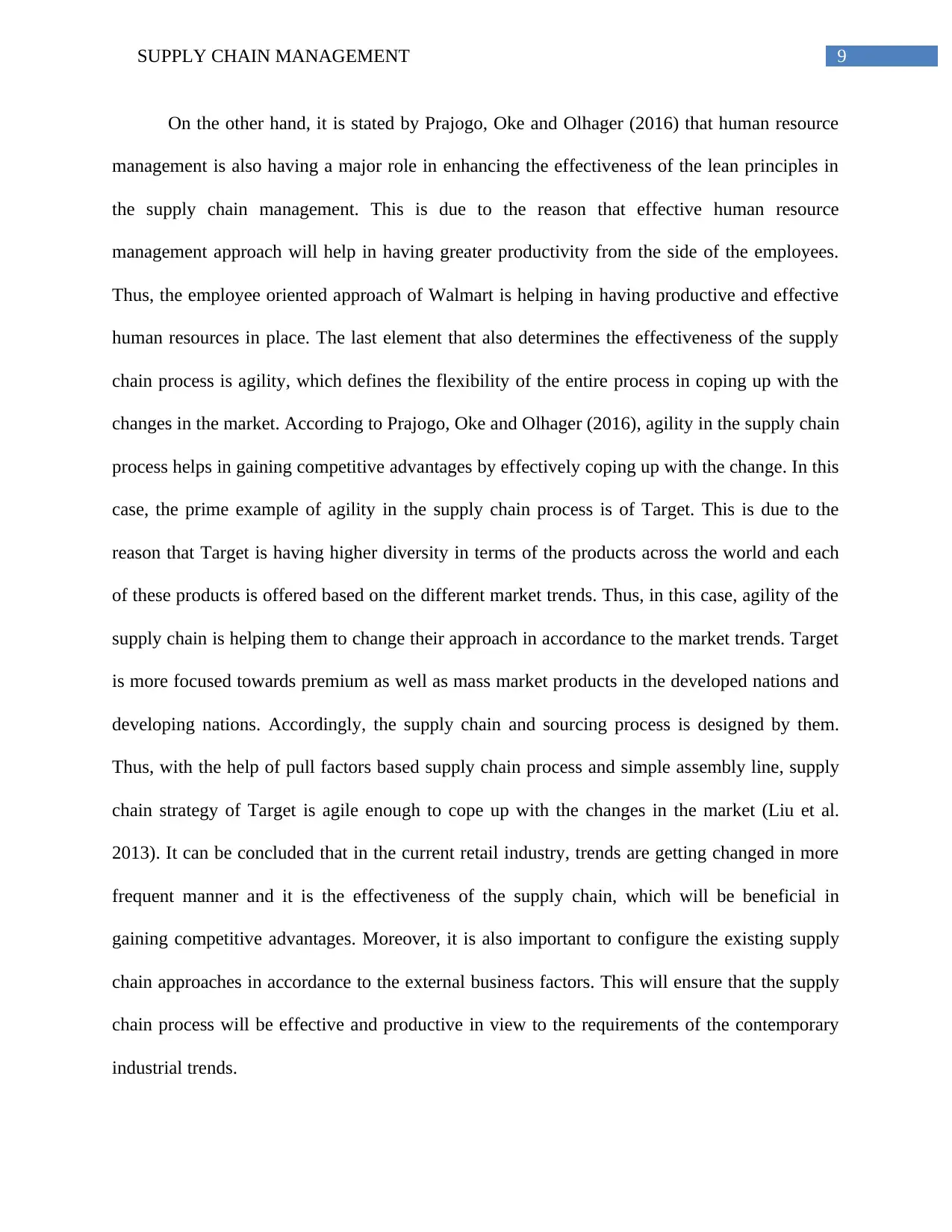
9SUPPLY CHAIN MANAGEMENT
On the other hand, it is stated by Prajogo, Oke and Olhager (2016) that human resource
management is also having a major role in enhancing the effectiveness of the lean principles in
the supply chain management. This is due to the reason that effective human resource
management approach will help in having greater productivity from the side of the employees.
Thus, the employee oriented approach of Walmart is helping in having productive and effective
human resources in place. The last element that also determines the effectiveness of the supply
chain process is agility, which defines the flexibility of the entire process in coping up with the
changes in the market. According to Prajogo, Oke and Olhager (2016), agility in the supply chain
process helps in gaining competitive advantages by effectively coping up with the change. In this
case, the prime example of agility in the supply chain process is of Target. This is due to the
reason that Target is having higher diversity in terms of the products across the world and each
of these products is offered based on the different market trends. Thus, in this case, agility of the
supply chain is helping them to change their approach in accordance to the market trends. Target
is more focused towards premium as well as mass market products in the developed nations and
developing nations. Accordingly, the supply chain and sourcing process is designed by them.
Thus, with the help of pull factors based supply chain process and simple assembly line, supply
chain strategy of Target is agile enough to cope up with the changes in the market (Liu et al.
2013). It can be concluded that in the current retail industry, trends are getting changed in more
frequent manner and it is the effectiveness of the supply chain, which will be beneficial in
gaining competitive advantages. Moreover, it is also important to configure the existing supply
chain approaches in accordance to the external business factors. This will ensure that the supply
chain process will be effective and productive in view to the requirements of the contemporary
industrial trends.
On the other hand, it is stated by Prajogo, Oke and Olhager (2016) that human resource
management is also having a major role in enhancing the effectiveness of the lean principles in
the supply chain management. This is due to the reason that effective human resource
management approach will help in having greater productivity from the side of the employees.
Thus, the employee oriented approach of Walmart is helping in having productive and effective
human resources in place. The last element that also determines the effectiveness of the supply
chain process is agility, which defines the flexibility of the entire process in coping up with the
changes in the market. According to Prajogo, Oke and Olhager (2016), agility in the supply chain
process helps in gaining competitive advantages by effectively coping up with the change. In this
case, the prime example of agility in the supply chain process is of Target. This is due to the
reason that Target is having higher diversity in terms of the products across the world and each
of these products is offered based on the different market trends. Thus, in this case, agility of the
supply chain is helping them to change their approach in accordance to the market trends. Target
is more focused towards premium as well as mass market products in the developed nations and
developing nations. Accordingly, the supply chain and sourcing process is designed by them.
Thus, with the help of pull factors based supply chain process and simple assembly line, supply
chain strategy of Target is agile enough to cope up with the changes in the market (Liu et al.
2013). It can be concluded that in the current retail industry, trends are getting changed in more
frequent manner and it is the effectiveness of the supply chain, which will be beneficial in
gaining competitive advantages. Moreover, it is also important to configure the existing supply
chain approaches in accordance to the external business factors. This will ensure that the supply
chain process will be effective and productive in view to the requirements of the contemporary
industrial trends.
Paraphrase This Document
Need a fresh take? Get an instant paraphrase of this document with our AI Paraphraser
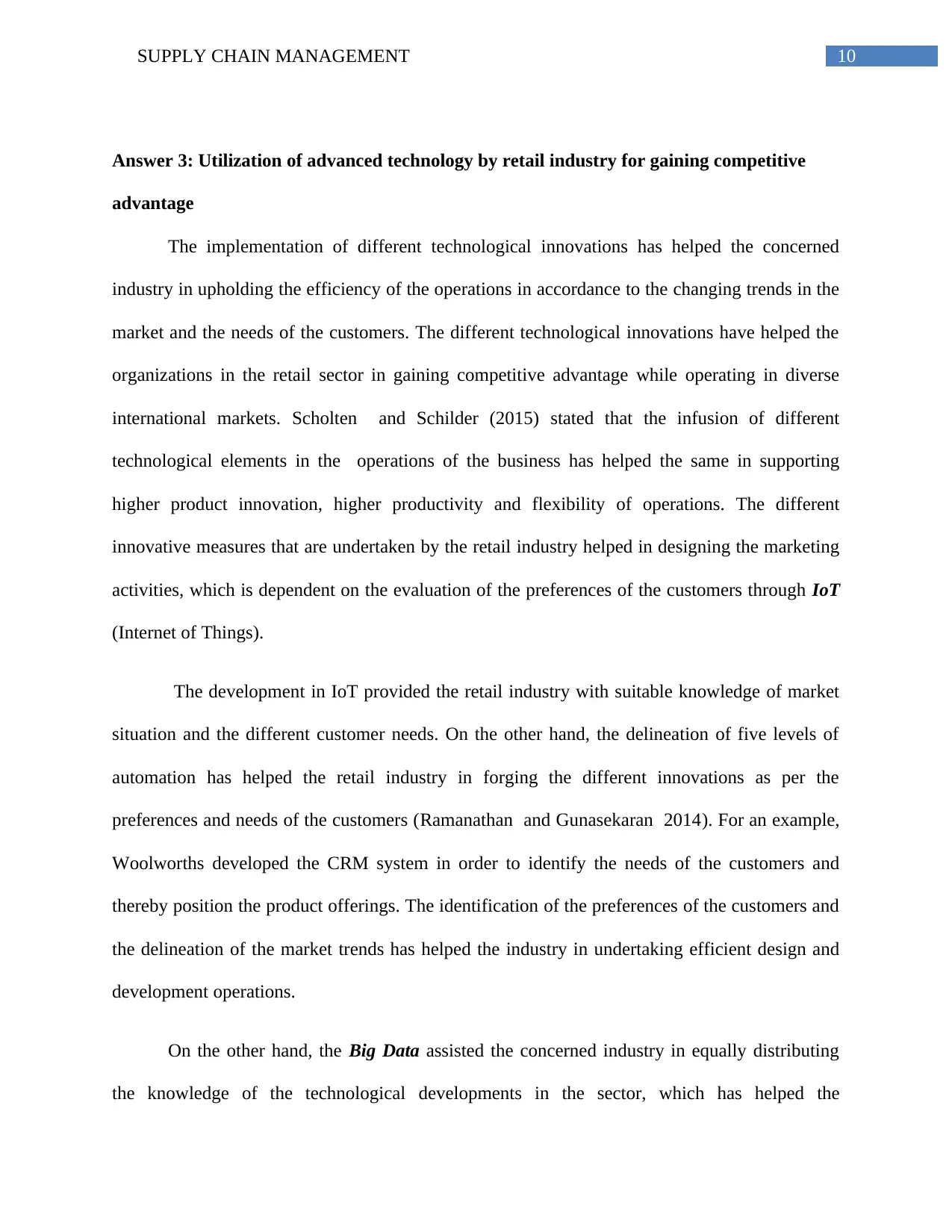
10SUPPLY CHAIN MANAGEMENT
Answer 3: Utilization of advanced technology by retail industry for gaining competitive
advantage
The implementation of different technological innovations has helped the concerned
industry in upholding the efficiency of the operations in accordance to the changing trends in the
market and the needs of the customers. The different technological innovations have helped the
organizations in the retail sector in gaining competitive advantage while operating in diverse
international markets. Scholten and Schilder (2015) stated that the infusion of different
technological elements in the operations of the business has helped the same in supporting
higher product innovation, higher productivity and flexibility of operations. The different
innovative measures that are undertaken by the retail industry helped in designing the marketing
activities, which is dependent on the evaluation of the preferences of the customers through IoT
(Internet of Things).
The development in IoT provided the retail industry with suitable knowledge of market
situation and the different customer needs. On the other hand, the delineation of five levels of
automation has helped the retail industry in forging the different innovations as per the
preferences and needs of the customers (Ramanathan and Gunasekaran 2014). For an example,
Woolworths developed the CRM system in order to identify the needs of the customers and
thereby position the product offerings. The identification of the preferences of the customers and
the delineation of the market trends has helped the industry in undertaking efficient design and
development operations.
On the other hand, the Big Data assisted the concerned industry in equally distributing
the knowledge of the technological developments in the sector, which has helped the
Answer 3: Utilization of advanced technology by retail industry for gaining competitive
advantage
The implementation of different technological innovations has helped the concerned
industry in upholding the efficiency of the operations in accordance to the changing trends in the
market and the needs of the customers. The different technological innovations have helped the
organizations in the retail sector in gaining competitive advantage while operating in diverse
international markets. Scholten and Schilder (2015) stated that the infusion of different
technological elements in the operations of the business has helped the same in supporting
higher product innovation, higher productivity and flexibility of operations. The different
innovative measures that are undertaken by the retail industry helped in designing the marketing
activities, which is dependent on the evaluation of the preferences of the customers through IoT
(Internet of Things).
The development in IoT provided the retail industry with suitable knowledge of market
situation and the different customer needs. On the other hand, the delineation of five levels of
automation has helped the retail industry in forging the different innovations as per the
preferences and needs of the customers (Ramanathan and Gunasekaran 2014). For an example,
Woolworths developed the CRM system in order to identify the needs of the customers and
thereby position the product offerings. The identification of the preferences of the customers and
the delineation of the market trends has helped the industry in undertaking efficient design and
development operations.
On the other hand, the Big Data assisted the concerned industry in equally distributing
the knowledge of the technological developments in the sector, which has helped the
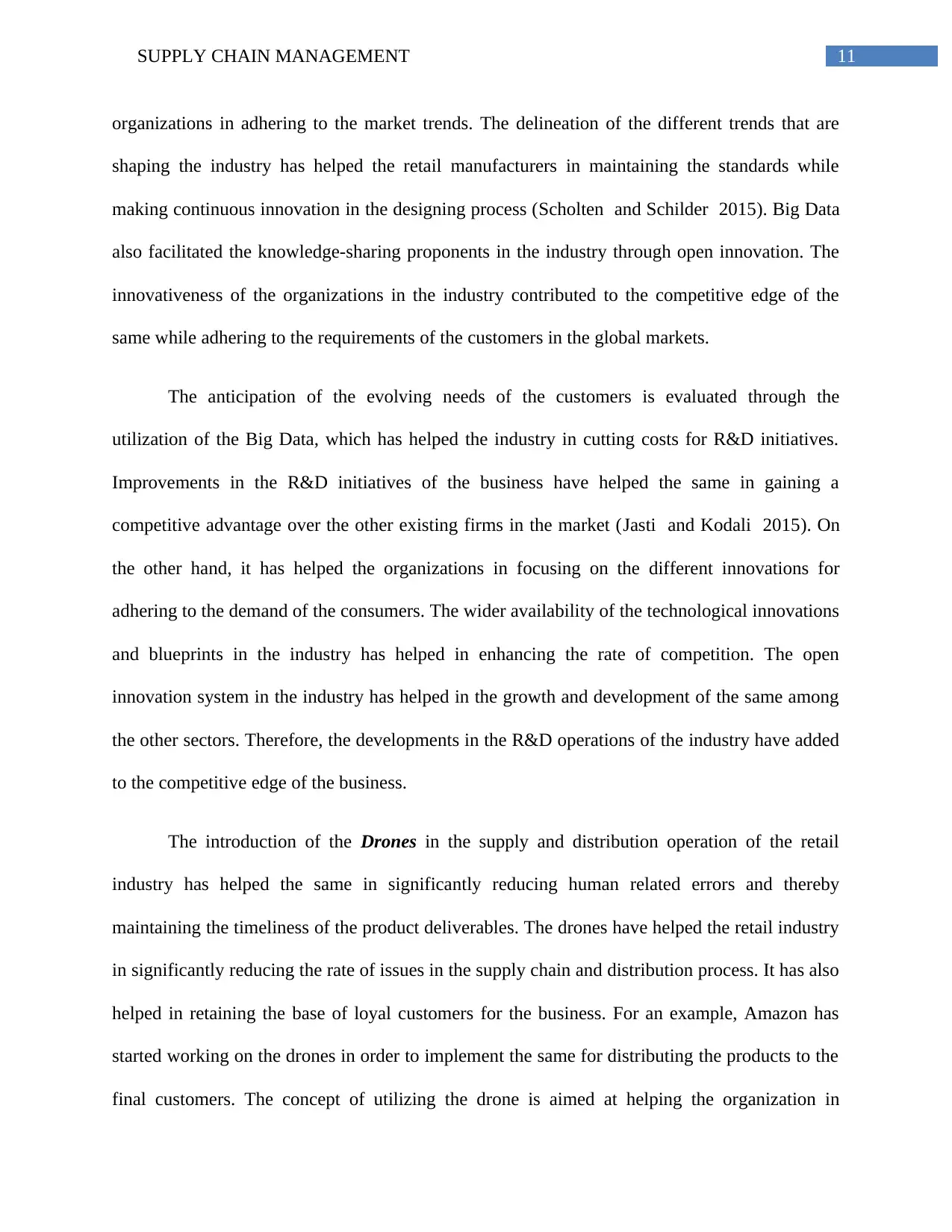
11SUPPLY CHAIN MANAGEMENT
organizations in adhering to the market trends. The delineation of the different trends that are
shaping the industry has helped the retail manufacturers in maintaining the standards while
making continuous innovation in the designing process (Scholten and Schilder 2015). Big Data
also facilitated the knowledge-sharing proponents in the industry through open innovation. The
innovativeness of the organizations in the industry contributed to the competitive edge of the
same while adhering to the requirements of the customers in the global markets.
The anticipation of the evolving needs of the customers is evaluated through the
utilization of the Big Data, which has helped the industry in cutting costs for R&D initiatives.
Improvements in the R&D initiatives of the business have helped the same in gaining a
competitive advantage over the other existing firms in the market (Jasti and Kodali 2015). On
the other hand, it has helped the organizations in focusing on the different innovations for
adhering to the demand of the consumers. The wider availability of the technological innovations
and blueprints in the industry has helped in enhancing the rate of competition. The open
innovation system in the industry has helped in the growth and development of the same among
the other sectors. Therefore, the developments in the R&D operations of the industry have added
to the competitive edge of the business.
The introduction of the Drones in the supply and distribution operation of the retail
industry has helped the same in significantly reducing human related errors and thereby
maintaining the timeliness of the product deliverables. The drones have helped the retail industry
in significantly reducing the rate of issues in the supply chain and distribution process. It has also
helped in retaining the base of loyal customers for the business. For an example, Amazon has
started working on the drones in order to implement the same for distributing the products to the
final customers. The concept of utilizing the drone is aimed at helping the organization in
organizations in adhering to the market trends. The delineation of the different trends that are
shaping the industry has helped the retail manufacturers in maintaining the standards while
making continuous innovation in the designing process (Scholten and Schilder 2015). Big Data
also facilitated the knowledge-sharing proponents in the industry through open innovation. The
innovativeness of the organizations in the industry contributed to the competitive edge of the
same while adhering to the requirements of the customers in the global markets.
The anticipation of the evolving needs of the customers is evaluated through the
utilization of the Big Data, which has helped the industry in cutting costs for R&D initiatives.
Improvements in the R&D initiatives of the business have helped the same in gaining a
competitive advantage over the other existing firms in the market (Jasti and Kodali 2015). On
the other hand, it has helped the organizations in focusing on the different innovations for
adhering to the demand of the consumers. The wider availability of the technological innovations
and blueprints in the industry has helped in enhancing the rate of competition. The open
innovation system in the industry has helped in the growth and development of the same among
the other sectors. Therefore, the developments in the R&D operations of the industry have added
to the competitive edge of the business.
The introduction of the Drones in the supply and distribution operation of the retail
industry has helped the same in significantly reducing human related errors and thereby
maintaining the timeliness of the product deliverables. The drones have helped the retail industry
in significantly reducing the rate of issues in the supply chain and distribution process. It has also
helped in retaining the base of loyal customers for the business. For an example, Amazon has
started working on the drones in order to implement the same for distributing the products to the
final customers. The concept of utilizing the drone is aimed at helping the organization in
⊘ This is a preview!⊘
Do you want full access?
Subscribe today to unlock all pages.

Trusted by 1+ million students worldwide
1 out of 17
Related Documents
Your All-in-One AI-Powered Toolkit for Academic Success.
+13062052269
info@desklib.com
Available 24*7 on WhatsApp / Email
![[object Object]](/_next/static/media/star-bottom.7253800d.svg)
Unlock your academic potential
Copyright © 2020–2025 A2Z Services. All Rights Reserved. Developed and managed by ZUCOL.





